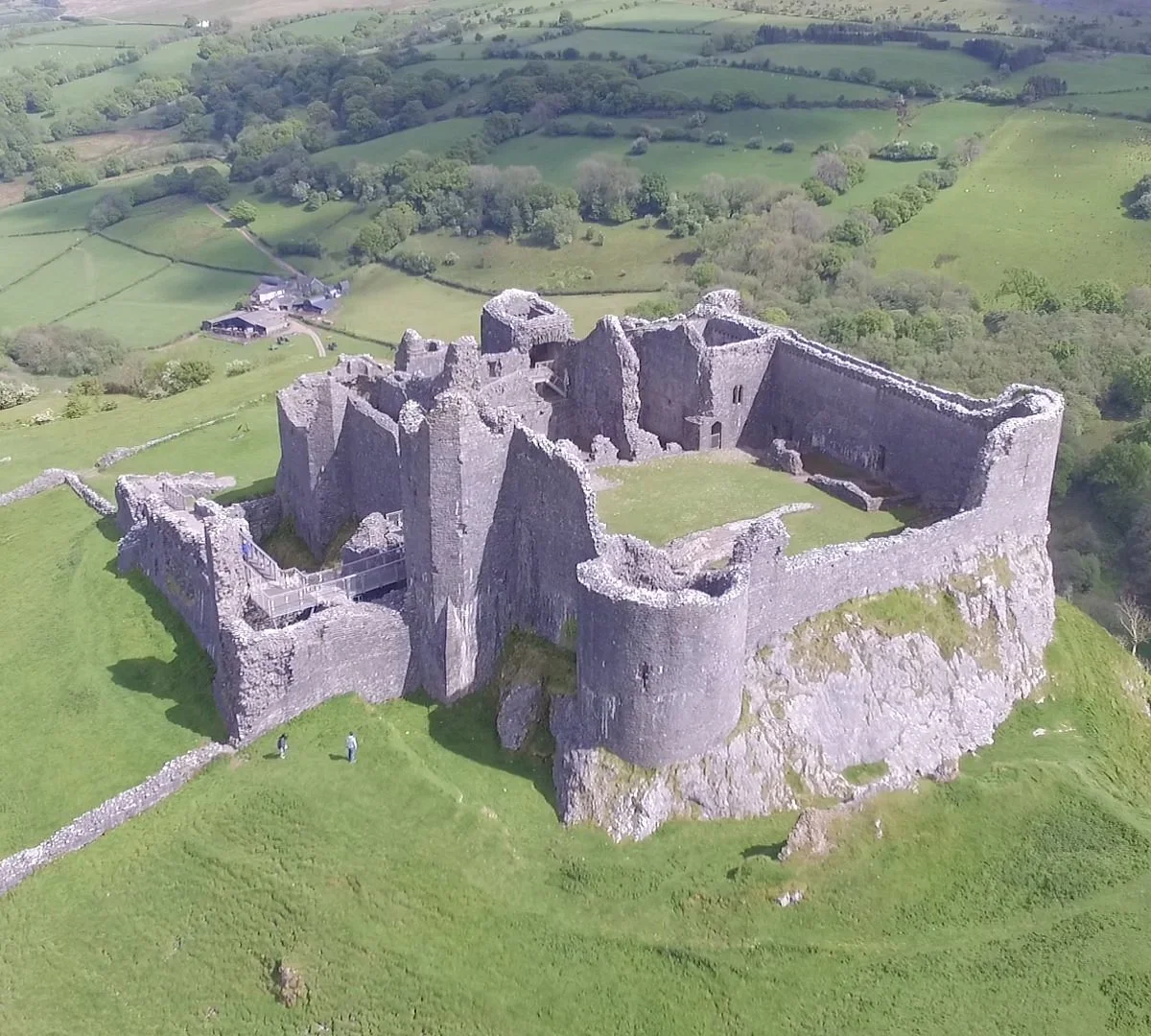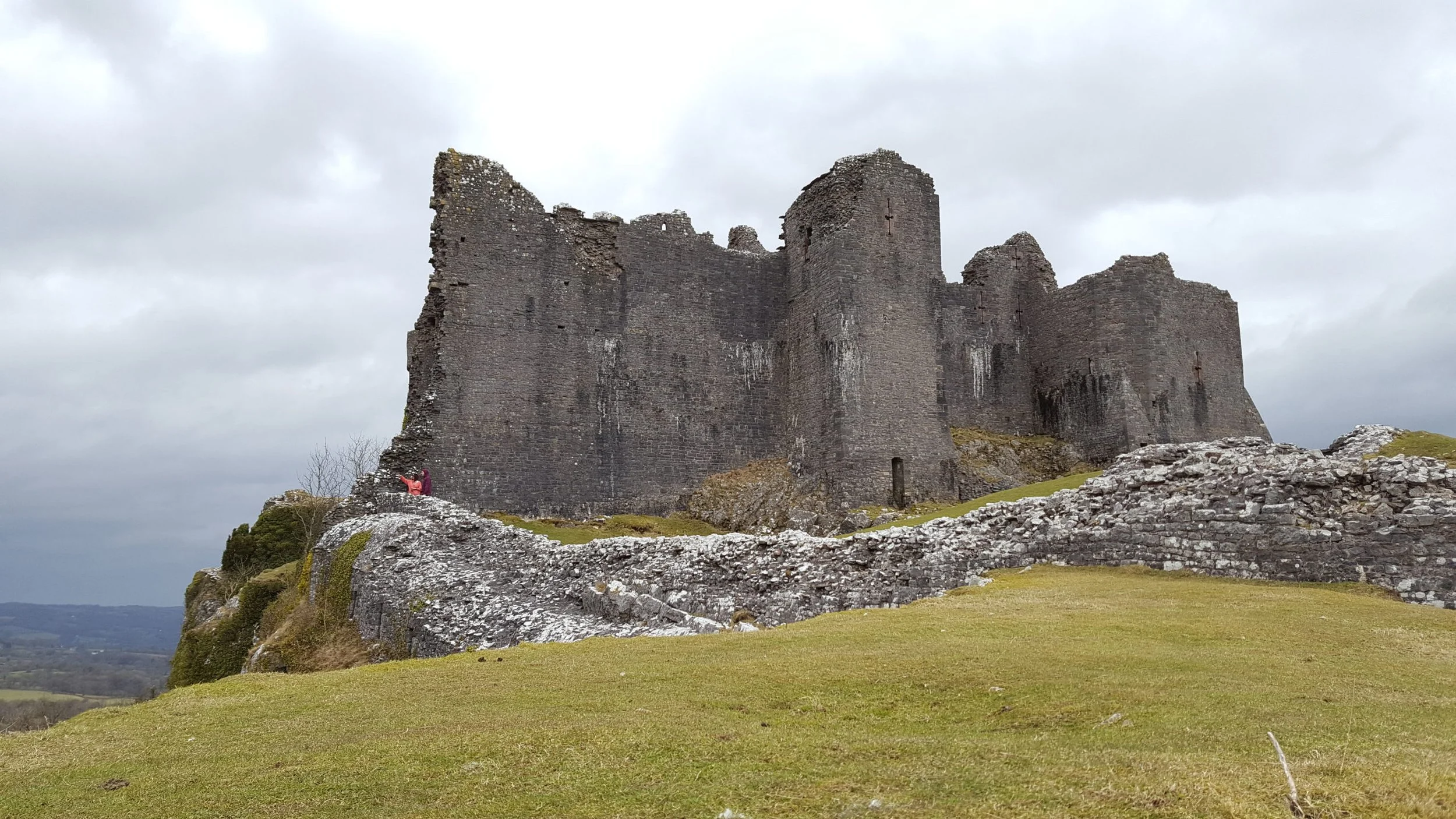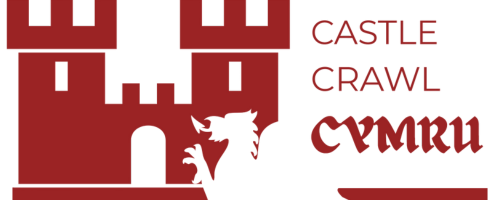Carreg Cennen Castle | Visit Welsh Castles
Carreg Cennen Castle is one of the most dramatically sited castles in Wales. It stands on a high limestone crag above the River Cennen in Carmarthenshire.
The first fortification on the site likely dates to the 12th century. The stone castle seen today was built by John Giffard in the late 13th century during Edward I’s conquest of Wales.
The castle is known for its striking location, solid defences, and unusual underground passageway leading to a natural cave. Although now a ruin, it remains a powerful reminder of medieval military architecture in the Welsh Marches.
Quick Facts
Date of construction: Late 13th century (stone structure), with earlier fortifications from the 12th century
Location: Near Trapp, Carmarthenshire, South Wales
Who built it: John Giffard, a Marcher Lord under Edward I
Key purpose or historical use: Military stronghold and border control during the conquest of Wales
A Brief History
The first fortification at Carreg Cennen was likely built by the Welsh prince Rhys ap Gruffydd in the 12th century. It changed hands several times during periods of conflict between the native Welsh and the Normans.
In the late 13th century, Edward I granted the land to John Giffard, a trusted Marcher Lord. Giffard rebuilt the castle in stone. Its position made it ideal for surveillance and defence during Edward’s campaign to conquer Wales.
In 1403, Owain Glyndŵr's forces captured the castle during his rebellion against English rule. It was recaptured soon after by the Crown. By the 15th century, Carreg Cennen’s military role declined. During the Wars of the Roses in 1462, the Yorkists partially demolished the castle to stop it falling into enemy hands.
The castle has remained a ruin since that time. In the 20th century, it passed into the guardianship of Cadw and became open to the public.
Features and Layout
Carreg Cennen Castle stands on a limestone cliff over 90 metres above the River Cennen. Its natural position provides strong defences on all sides.
The castle layout includes an inner ward, outer ward, gatehouse, and a large curtain wall. The twin-towered gatehouse controlled access and added extra protection. The inner ward holds the remains of the hall, chapel, and living quarters.
One of the most unusual features is a vaulted passageway that leads to a natural cave. This may have been used as a water source or as an escape route.
The castle also has latrines, arrow slits, and a rock-cut ditch that enhances the cliff's natural defences. Most of the visible structure today dates from John Giffard’s 13th-century rebuild.
Images





Legends and Stories
Carreg Cennen Castle carries ghostly tales and local folklore, each rooted in Welsh tradition.
Local legend speaks of the Blue Lady. She appears at night, dressed in pale blue. Some believe she searches for a lost child. This tale catches at your imagination. The story appears in accounts of haunted Welsh castles.
Others report seeing a lady in white wandering the ruins. She might be a nun or a betrayed lover. This story is noted in a Castle Crawl Cymru listing.
Another tale comes from Llandeilo local lore. It says a valiant knight—or perhaps even King Arthur—lies beneath the castle, asleep. He will rise once Welsh land faces dire peril.
These stories share a Celtic motif. They echo the Welsh tradition of Y Ladi Wen,the White Lady. She often appears to guide or warn, sometimes linked to hidden.
Visiting
Opening times and ticket prices
The castle and its tea rooms open daily at 9:30 am, except on Christmas Day. From 1 April to 31 October, they close at 5:30 pm (last admission 4:30 pm); from 1 November to 31 March, closing is at 4:30 pm (last entry 3:30 pm).
For summer, ticket prices are:
Adult: £7.70
Senior (65+): £6.90
Junior (5–17), students, armed forces, veterans: £5.30
Family ticket (two adults + up to three children): £24.60
Children under five: free.
Directions and transport
The castle sits at Trapp, Llandeilo SA19 6UA. From Llandeilo (5 km away), take the A483 and then minor roads to the farm entrance.
The nearest railway station is Ffairfach on the Heart of Wales line; it lies roughly 5 km away. Regular bus services (routes 280/281) run between Carmarthen, Llandeilo, and Llandovery, with stops about 3 miles from the castle. A steep 10–15‑minute walk leads from the car park to the site.
Facilities and accessibility
The site offers free farmyard parking (approx. 50 spaces) and bike storage cadw.gov.wales. A café/tea room and gift shop open daily with baby-changing facilities.
Portable induction loops are available for hearing assistance cadw.gov.wales. Paths are steep and uneven, with several steps and no railings in places. The natural cave requires torches, which you can borrow at entry.
Dog policy
Dogs are welcome on short leads in the grounds. Guide dogs may enter the tea room and shop
Nearby Attractions
The castle lies near several other places worth visiting.
Llandeilo
This small market town is just 5 km away. It has independent shops, cafés, and views over the River Towy. The 19th-century Dinefwr Castle and Newton House are also nearby, set in a National Trust estate.
Brecon Beacons National Park (Bannau Brycheiniog)
The castle sits near the park's western edge. Local trails offer walking routes with views of the Black Mountain range. Craig-y-Nos Country Park and Llyn y Fan Fach are both within a 30-minute drive.
Garn Goch Iron Age hillfort
Just south of Llandeilo, this twin-peaked hillfort has views across the Towy valley. It’s one of the largest of its kind in Wales and free to visit.
Aberglasney Gardens
Roughly 12 km from Carreg Cennen, this historic garden is known for its cloister walk and formal planting. It’s open daily year-round.
Visitor Tips
Wear sturdy footwear. The path up to the castle is steep and uneven. Inside the ruins, expect rough stone surfaces and drops with no railings.
Bring a torch. You’ll need it for the dark passage leading to the natural cave.
Check the weather before you go. The site is exposed, and there’s little shelter in bad conditions.
Arrive early or late in the day if you want to avoid school groups or coach tours. Mornings are often quiet.
There is no Wi-Fi or mobile signal at the castle. Plan your route in advance.
Dogs are welcome on leads, but bring water for them. The walk from the car park to the gate is uphill.
Use the tea room before or after your visit. It has toilets, hot food, and a gift shop with Welsh produce.
FAQs
-
Yes. Dogs on short leads are welcome in the castle grounds. Assistance dogs can also enter the tea room and shop.
-
Yes. The route from the car park to the castle is steep and uneven. It takes 10–15 minutes on foot.
-
Yes. The passage to the cave is open to visitors. You will need a torch. Torches are available at the entrance if you don’t bring one.
-
Children can enjoy the visit, but some areas are steep or exposed. Keep a close eye, especially near drops and the cave.
-
Yes. There is a tea room near the car park. It serves light meals, drinks, and local produce.
-
The nearest station is Ffairfach, around 5 km away. Llandeilo station is slightly farther but has more frequent services.
Wrapping it Up
This offers a striking mix of history and scenery. Built in the 13th century, it served as a military stronghold on the edge of the Welsh heartland. Today, it remains one of the most impressive castle ruins in South Wales.
You’ll need good footwear and a torch for your visit. The path is steep, and the cave is dark. Dogs are welcome, and there’s a tea room for food and rest. If you’re exploring Carmarthenshire or the western Brecon Beacons, Carreg Cennen makes a memorable stop.




Coity Castle is a medieval stronghold situated near Bridgend in South Wales. The site features a combination of Norman military architecture and later domestic buildings.